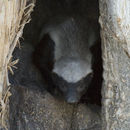tr
kırıntılardaki isimler


Perception Channels: tactile ; chemical
The ratel has a wide range, but it is rare in this homeland. As a nomadic predator, its need for lots of space makes it threatened in areas of human development. This threat has been answered by some governments with laws of protection. In Israel, killing a ratel is punishable by imprisonment. Some scientists, however, question the reliability of some of these claims. It can be hard to track an animal with such a wide home range who is also secretive and nomadic. This could be why so few of these animals are ever spotted. (Killingly and Long, 1983. National Geographic, 1981)
IUCN Red List of Threatened Species: least concern
Some ratels have attacked domestic sheep for food. Ratels can also be harmful to humans when frightened. (Killingly and Long, 1983)
The ratel keeps down the population of disease carrying rodents and annoying insects. In the past, pelts have been sold for their attractiveness. (Killingly and Long, 1983)
As a predator, the ratel uses its quickness to run down much of its prey. It attacks even poisonous snakes, relying on its shaggy coat to protect it from harm. Squat and muscular, the ratel is ready for battle, having been known to attack animals much larger than itself such as the African buffalo, the gnu, or waterbuck. The ratel is omnivorous. It is most often observed consuming small reptiles, rodents, birds, insects and even carrion but it also eats fruits, berries, roots, plants, and eggs. Ratels frequently attack bee hives, to eat the stored honey and larval bees. This habit has resulted in the evolution of a mutualistic relationship between the ratel and the greater honey guide bird, Indicator indicator, which eats honey, larvae, and wax from bee hives. (Killingly and Long, 1983; Neal, 1986)
Animal Foods: birds; mammals; amphibians; reptiles; eggs; carrion ; insects; terrestrial non-insect arthropods
Plant Foods: roots and tubers; fruit
Primary Diet: omnivore
The ratel is found all across Africa, the Middle East, and India, but it does not live in deserts where the climate is hot and arid, and nor in equatorial jungles that are too wet and too dense. (Killingly and Long, 1983)
Biogeographic Regions: oriental (Native ); ethiopian (Native )
The ratel exists mostly in temperate climates, and not in overtly hot and arid, or wet and dense ones, such as jungles and deserts. (Neal, 1986. Killingly and Long, 1983)
Terrestrial Biomes: savanna or grassland ; forest
Average lifespan
Status: wild: 26.4 years.
Average lifespan
Status: captivity: 26.5 years.
The ratel's head and body are, on average, 0.8 meters (2.4 feet) in length with the tail up to 0.3 meters (.9 feet) long. On average, the female is only slightly smaller than the male. The ratel is black, with a white stripe that originates just above the eyes and terminates at the tip of the tail, covering nearly the entire width of the back, from shoulder to shoulder. (Killingly and Long, 1983; Rosevear, 1974)
Range mass: 9 to 12 kg.
Other Physical Features: endothermic ; bilateral symmetry
Though mating may not be strictly reserved for a specific season, it usually occurs in September and October. After a gestation period of around six months, one to four cubs, usually two, are born in April or May. The cubs are hairless, blind, and lack the coloration of the adult ratel. Because the animal is so secretive very little is known about its reproduction. (Neal, 1986. Rosevear, 1974)
Key Reproductive Features: gonochoric/gonochoristic/dioecious (sexes separate); sexual
Average birth mass: 210 g.
Average gestation period: 180 days.
Average number of offspring: 2.